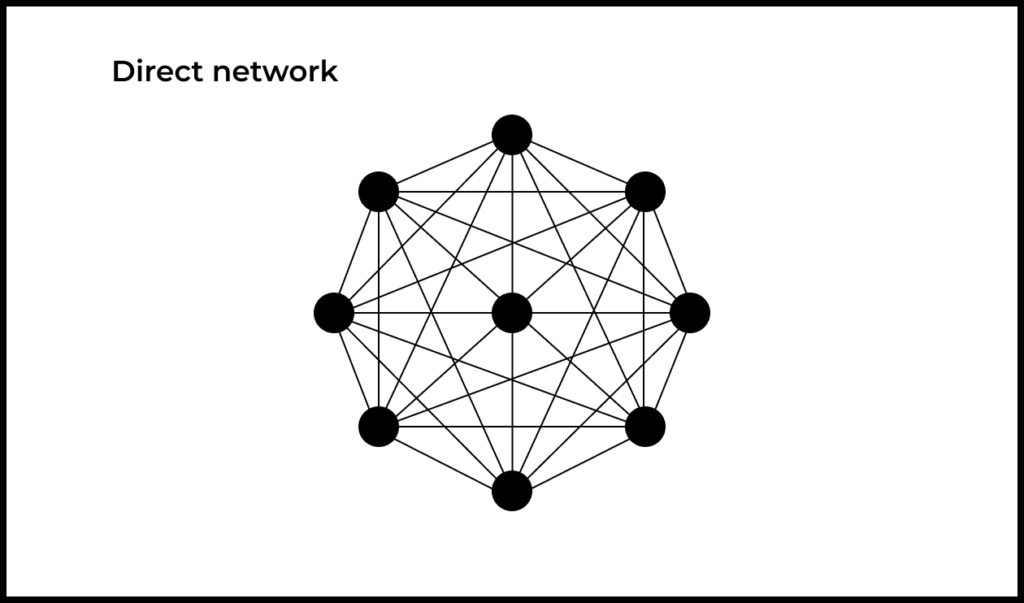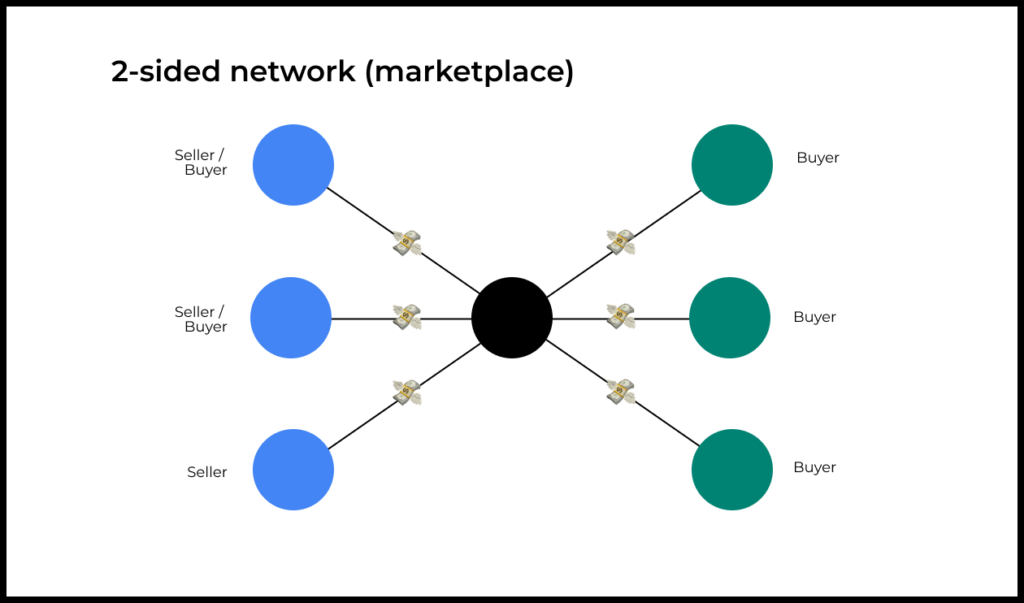Some products, like word processors and photo editors, are oriented around functionality. People use them because they have good features. Other products, like messenger apps and social networks, draw their value from their audience. People come to them because that is the other people that use them.
When a product’s value increases as more people use it, it is said to have “network effects.” Network effects are the silent growth engines behind some of the most successful products, from Facebook to Uber, and from Airbnb to WhatsApp.
Network effects act as a multiplier, where the value of a product or service increases exponentially as more people use it, creating a powerful incentive for new users to join and stay engaged. Understanding network effects is not only beneficial but also crucial for product managers who want to turn a good idea into a lasting business.
When a product’s advantage is its network effects, the competition shifts away from functionality. It means that for competitors to challenge a product defended by network effects, reproducing its functionality isn’t enough unless it also matches or exceeds the established user network’s magnitude. In many cases, even superior functionality doesn’t make up for the advantage of network effects.
While network effects are very attractive, they are easier said than done and they do not apply to all products. Network effects also come in various forms, each with its nuances and challenges. The three prevalent types are direct network effects, where value grows with user numbers; multi-sided network effects, involving multiple types of user groups; and data network effects, where value is derived from the data generated by users.
You’ll find a quiz at the end of the article to test your knowledge!
→ Test your product management and data skills with this free Growth Skills Assessment Test.
→ Learn data-driven product management in Simulator by GoPractice.
→ Learn growth and realize the maximum potential of your product in Product Growth Simulator.
→ Learn to apply generative AI to create products and automate processes in Generative AI for Product Managers – Mini Simulator.
→ Learn AI/ML through practice by completing four projects around the most common AI problems in AI/ML Simulator for Product Managers.
Direct network effects

You can see direct network effects in messenger applications, where the primary value lies in connectivity: the more people use the app, the more valuable it becomes to each user. This growing value acts as a formidable defense mechanism against competitors. It’s a simple yet powerful concept: a messenger app’s worth is directly tied to its user base. Consequently, a new entrant must overcome a significant hurdle—it must not only match the incumbent’s features but also its expansive network.
Take WhatsApp, for instance. A user is more likely to choose it over a new app simply because it’s where their social circle is already active. The established network of users in WhatsApp creates a gravitational pull, attracting more users and reinforcing its dominance. If a developer wants to launch a new messenger application, their product’s added value must be strong enough to not only convince new users to switch but also motivate them to persuade their own contacts to join the app.
Direct network effects are not confined to messaging apps. Social media giants like Facebook, Twitter, Instagram, Telegram, and TikTok all benefit from direct network effects, where users are more likely to join platforms where their friends and people of interest are.
The principles of direct network extend beyond the digital realm, as seen in the traditional telephone network where the utility of the service grows with each new subscriber. The telephone itself is a simple gadget that is not hard to produce. Its real value is in the network of people you can reach.
Examples of products that enjoy direct network effects:
- Facebook;
- WhatsApp;
- Twitter;
- Instagram;
- Telegram;
- TikTok.
Multi-sided network effects

An example of multi-sided network effects is online shopping platforms like eBay and Amazon, which bring together different types of users—buyers and sellers. As more sellers list their products, the platform becomes more attractive to buyers seeking variety and competitive pricing. Conversely, an influx of buyers draws in sellers eager for a larger customer base. This interdependence between the two sides fuels a self-reinforcing cycle of growth.
For a new company aiming to enter this space, the challenge is to offer unique value that the established giants don’t. Niche marketplaces like Veepee, with its time-limited sales for members, or Etsy’s focus on handmade and vintage items, exemplify successful strategies that carve out distinct spaces by catering to specific needs. These platforms then establish their own multisided network effects around their core value proposition.
Multi-sided network effects can be seen in different types of products. Ride-hailing services like Uber connect riders with drivers, each group attracting the other. Operating systems are another example, where a rich selection of apps draws users, and a large user base, in turn, attracts developers. These ecosystems thrive by continuously amplifying the value for all participants as they scale.
The key difference between direct and multi-sided network effects is the different types of user groups. Maintaining multi-sided network effects is more challenging as you must maintain the balance between the different sides of the network. For example, in an online marketplace, you must make sure that the supply (sellers) and demand (buyers) match each other. In ride-hailing apps, you must make sure there are enough riders to create demand and enough drivers to meet that demand.
Examples of products that enjoy multi-sided network effects:
- eBay;
- Amazon;
- Uber;
- Etsy;
- Thumbtack.
Data network effects

Data network effects apply to products that improve not just through user growth but also through user engagement. Consider search engines: they all follow a core functionality, but their efficiency increases as they learn from user interactions. Each click and query refine their algorithms, enabling them to provide more relevant results and enhance the user experience.
When a product has data network effects, as users interact with it, they generate data, which in turn is used to optimize the product. This improved performance encourages more frequent use, creating a feedback loop of continuous enhancement. Google’s dominance in the search market is a testament to this effect. By analyzing vast amounts of search data, Google delivers increasingly relevant results, cementing its market leadership.
Data network effects are also evident in AI applications like ChatGPT, which evolves as it digests more user input. Similarly, recommendation engines sharpen their suggestions by analyzing user-product interactions. The more data these systems access, the more accurate they become, and the harder it gets for competitors to copy them.
Google Maps is another prime example. It doesn’t just benefit from the number of users but also from the richness of traffic data they provide. As more people use Google Maps, the service becomes adept at predicting traffic patterns and suggesting efficient routes, thereby attracting even more users. In each case, the data network effect creates a virtuous cycle where data begets quality, and quality brings new users, generating even more data to amplify the cycle.
Examples of products that enjoy data network effects:
- Google;
- Waze;
- Spotify;
- ChatGPT.
Multiple network effects
Products that harness multiple network effects simultaneously can create formidable effects. Consider Facebook and Twitter/X, which leverage direct network effects as their user bases expand. Each new user enhances the value for others by potentially expanding their social network. Concurrently, these platforms benefit from data network effects. They analyze user interactions to curate and recommend content that matches user preferences, making the platforms more engaging.
This dual advantage is potent. Users flock to these social networks not just for the connections but also for the personalized, relevant content they expect to find, a result of the platforms’ data-driven insights. The synergy between direct and data network effects makes the platforms increasingly indispensable to their users.
Amazon exemplifies a similar strategy in the e-commerce domain. It thrives on multi-sided network effects, creating a vast nexus of buyers and sellers. This network becomes more valuable as it grows, attracting even more participants. Simultaneously, Amazon harnesses data from user interactions to refine its product recommendations and search algorithms, enhancing the shopping experience. This dual approach gives Amazon an edge, drawing new buyers who come not only for the extensive seller network but also for the ease with which they can discover and purchase what they need.
Employing network effects in tandem, therefore, is a powerful strategy, creating a multi-layered moat that secures a product’s market position.
Limits and considerations
Leveraging network effects early and aggressively can secure a product’s market position over the long term. Indeed, many successful companies worth hundreds of billions of dollars have built their businesses around products with network effects. Whether through direct, multi-sided, or data-driven interactions, these effects can be a linchpin for sustainable competitive advantage, making a product not just popular but essential to its users.
However, network effects are not universally applicable; they resonate most in products where user interaction is a core component. Take a single-player game, for instance. Its value remains unchanged regardless of its user base size, as the gameplay experience is solitary. However, by integrating multiplayer features, leaderboards, competitions, and group rewards, the same game can create an opportunity for network effects. New players might decide to install the game not only because of its single-player fun, but also because of the opportunity to be entertained along with other players who are already on the platform.
It’s crucial to distinguish network effects from viral growth strategies. If a game creates a referral program that rewards players with in-game currency for inviting others, it may accelerate user acquisition, but this doesn’t inherently increase the game’s value with each new user. This is viral growth, not a network effect.
However, viral growth and network effects can be mixed. Consider a product for storing files in the cloud. Initially, the product offers personal storage, which, while useful, doesn’t intrinsically benefit from more users. By adding file sharing and collaborative features, the service begins to develop direct network effects. Users derive more value from the ability to work together on their documents in real time, and the product becomes stickier.
To amplify these effects, a viral growth loop can be introduced. For example, the product can add a referral program that offers additional storage for each new user invited who collaborates on a shared file. This can incentivize current users to bring in their network. This not only increases the user base but also enhances the collaborative aspect of the service, strengthening the network effects.
One of the key challenges of network effects is the “cold start problem.” Without having enough user mass, the network effects don’t kick in. And if there is already a market leader that is benefiting from network effects, new products will have an even harder time gaining traction. This is why network effects are often assisted with other mechanisms, such as the viral growth loop mentioned above.
Test your knowledge
Take this brief quiz to identify which types of network effects are present in various well-known products. Remember, there could be multiple correct answers.
Learn more
Discover more about product virality and the “cold start problem” from the articles below:
— Product growth, reinvented: what growth hacking is (and isn’t)
— Solving the “Cold Start Problem”: expert tips and advice
Illustration by Anna Golde for GoPractice









